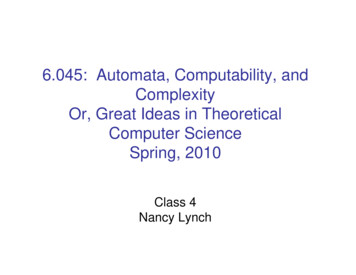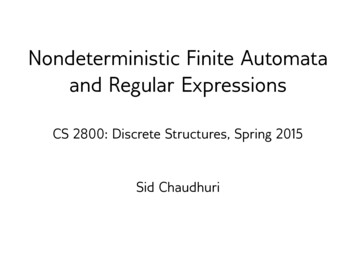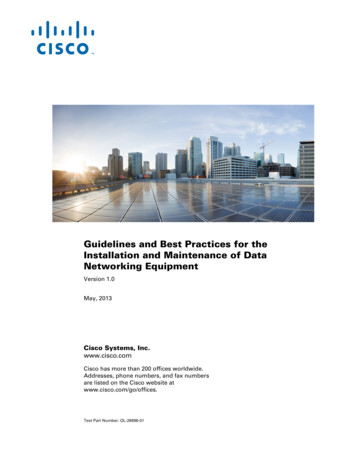
Transcription
6.045: Automata, Computability, andComplexityOr, Great Ideas in TheoreticalComputer ScienceSpring, 2010Class 4Nancy Lynch
Today Two more models of computation:– Nondeterministic Finite Automata (NFAs) Add a guessing capability to FAs. But provably equivalent to FAs.– Regular expressions A different sort of model---expressions rather than machines. Also provably equivalent. Topics:– Nondeterministic Finite Automata and the languages theyrecognize– NFAs vs. FAs– Closure of FA-recognizable languages under various operations,revisited– Regular expressions– Regular expressions denote FA-recognizable languages Reading: Sipser, Sections 1.2, 1.3 Next: Section 1.4
Nondeterministic Finite Automataand the languages theyrecognize
Nondeterministic Finite Automata Generalize FAs by adding nondeterminism, allowingseveral alternative computations on the same input string. Ordinary deterministic FAs follow one path on each input. Two changes:– Allow δ(q, a) to specify more than one successor state:aqa– Add ε-transitions, transitions made “for free”, without “consuming”any input symbols.q1 Formally, combine these changes:εq2
Formal Definition of an NFA An NFA is a 5-tuple ( Q, Σ, δ, q0, F ), where:– Q is a finite set of states,– Σ is a finite set (alphabet) of input symbols,– δ: Q Σε P(Q) is the transition function,The argumentsare a state and eitheran alphabet symbol orε. Σε means Σ {ε }.The result is a set of states.– q0 Q, is the start state, and– F Q is the set of accepting, or final states.
Formal Definition of an NFA An NFA is a 5-tuple ( Q, Σ, δ, q0, F ), where:– Q is a finite set of states,– Σ is a finite set (alphabet) of input symbols,– δ: Q Σε P(Q) is the transition function,– q0 Q, is the start state, and– F Q is the set of accepting, or final states. How many states in P(Q)?2 Q Example: Q { a, b, c }P(Q) { , {a}, {b}, {c}, {a,b}, {a,c}, {b,c}, {a,b,c} }
NFA Example 10,1aQ { a, b, c }Σ { 0, 1 }q0 aF {c}δ:0babc1c0{a,b} 1ε{a} {c}
NFA Example 20,1εaabcdefg01{a}{c} {g} {a} {d} {f} ε{b,c} b0c1dεe1f0g
Nondeterministic Finite Automata NFAs are like DFAs with two additions:– Allow δ(q, a) to specify more than one successor state.– Add ε-transitions. Formally, an NFA is a 5-tuple ( Q, Σ, δ, q0, F ),where:– Q is a finite set of states,– Σ is a finite set (alphabet) of input symbols,– δ: Q Σε P(Q) is the transition function,Σε means Σ {ε }.– q0 Q, is the start state, and– F Q is the set of accepting, or final states.
NFA ExamplesExample 1:0,10a1bcExample 2:0,1εab0c1dεe1f0g
How NFAs compute Informally:– Follow allowed arrows in any possible way,while “consuming” the designated inputsymbols.– Optionally follow any ε arrow at any time,without consuming any input.– Accepts a string if some allowed sequence oftransitions on that string leads to an acceptingstate.
Example 10,1a0b1c L(M) { w w ends with 01 } M accepts exactly the strings in this set. Computations for input word w 101:– Input word w: 1 0 1– States:a a a a– Or:a a b c Since c is an accepting state, M accepts 101
Example 10,1a0b1c Computations for input word w 0010:––––Possible states after 0: { a, b }Then after another 0: { a, b }After 1: { a, c }After final 0: { a, b } Since neither a nor b is accepting, M does notaccept 0010.000{ a } Æ { a, b } Æ { a, 1b } Æ { a, c } Æ { a, b }
Example 20,1εab0c1dεe1f0g L(M) { w w ends with 01 or 10 } Computations for w 0010:–––––Possible states after no input: { a, b, e }After 0: { a, b, e, c }After 0: { a, b, e, c }After 1: { a, b, e, d, f }After 0: { a, b, e, c, g } Since g is accepting, M accepts 0010.0100{ a, b, e } Æ { a, b, e, c } Æ { a, b, e, c} Æ { a, b, e, d, f } Æ { a, b, e, c, g }
Example 20,1εab0c1dεe1f0g Computations for w 0010:00{ a, b, e } Æ { a, b, e, c } Æ { a, b, e, c }10Æ { a, b, e, d, f } Æ { a, b, e, c, g } Path to accepting state:00ε 1 0aÆaÆaÆeÆfÆg
Viewing computations as a tree0,1εab0c1de1f0gInput w 01εa0In general, accept ifthere is a path labeledby the entire inputstring, possiblyinterspersed with εs,leading to anaccepting state.Here, leads to acceptingstate d.εa1aεεbeebεbεεStuck: Nomoves on εor 10ce1fStuck: Nomoves on εor 01dDone,accept
Formal definition of computation Define E(q) set of states reachable from q using zero ormore ε-moves (includes q itself). Example 2: E(a) { a, b, e } Define δ*: Q Σ* P(Q), state and string yield a set ofstates: δ*( q, w ) states that can be reached from q byfollowing w. Defined iteratively: Compute δ*( q, a1 a2 ak) by:S : E(q)for i 1 to k doS : r′ δ( r, ai) for some r in S E(r′) Or define recursively, LTTR.
Formal definition of computation δ*( q, w ) states that can be reached fromq by following w. String w is accepted if δ*( q0, w ) F ,that is, at least one of the possible endstates is accepting. String w is rejected if it isn’t accepted. L(M), the language recognized by NFA M, { w w is accepted by M}.
NFAs vs. FAs
NFAs vs. DFAs DFA Deterministic Finite Automaton, new name forordinary Finite Automata (FA).– To emphasize the difference from NFAs. What languages are recognized by NFAs? Since DFAs are special cases of NFAs, NFAs recognize atleast the DFA-recognizable (regular) languages. Nothing else! Theorem: If M is an NFA then L(M) is DFA-recognizable. Proof:– Given NFA M1 ( Q1, Σ, δ1, q01, F1 ), produce an equivalent DFA M2 ( Q2, Σ, δ2, q02, F2 ). Equivalent means they recognize the same language, L(M2) L(M1).– Each state of M2 represents a set of states of M1: Q2 P(Q1).– Start state of M2 is E(start state of M1) all states M1 could be inafter scanning ε: q02 E(q01).
NFAs vs. DFAs Theorem: If M is an NFA then L(M) is DFArecognizable. Proof:– Given NFA M1 ( Q1, Σ, δ1, q01, F1 ), produce anequivalent DFA M2 ( Q2, Σ, δ2, q02, F2 ).– Q2 P(Q1)– q02 E(q01)– F2 { S Q1 S F1 } Accepting states of M2 are the sets that contain an acceptingstate of M1.– δ2( S, a ) r S E( δ1( r, a ) ) Starting from states in S, δ2( S, a ) gives all states M1 could reachafter a and possibly some ε-transitions.– M2 recognizes L(M1): At any point in processing thestring, the state of M2 represents exactly the set of statesthat M1 could be in.
Example: NFA Æ DFA M1:0,1a0b1c States of M2: , {a}, {b}, {c}, {a,b}, {a,c}, {b,c},{a,b,c}10 δ2:F2{a}0{a,b}1{a,c}01 Other 5 subsets aren’t reachable from start state,don’t bother drawing them.
NFAs vs. DFAs NFAs and DFAs have the same power. But sometimes NFAs are simpler than equivalent DFAs. Example: L strings ending in 01 or 10– Simple NFA, harder DFA (LTTR) Example: L strings having substring 1010– Recall DFA:a– NFA:0,111b0,10c0d0,10111– Simpler---has the power to “guess” when to start matching.
NFAs vs. DFAs Which brings us back to last time. We got stuck in the proof of closure for DFAlanguages under concatenation: Example: L { 0, 1 }* { 0 } { 0 }*00,10 NFA can guess when the critical 0 occurs.
Closure of regular (FArecognizable) languages undervarious operations, revisited
Closure under operations The last example suggests we retry proofs ofclosure of FA languages under concatenation andstar, this time using NFAs. OK since they have the same expressive power(recognize the same languages) as DFAs. We already proved closure under common settheoretic operations---union, intersection,complement, difference---using DFAs. Got stuck on concatenation and star. First (warmup): Redo union proof in terms ofNFAs.
Closure under union Theorem: FA-recognizable languages are closedunder union. Old Proof:– Start with DFAs M1 and M2 for the same alphabet Σ.– Get another DFA, M3, with L(M3) L(M1) L(M2).– Idea: Run M1 and M2 “in parallel” on the same input. Ifeither reaches an accepting state, accept.
Closure under union1 Example:M1: Substring 0100a0,11b0M2: Odd number of 1s01de10M3:0ad1ae0bd010cd110be1cec1
Closure under union, general rule Assume:– M1 ( Q1, Σ, δ1, q01, F1 )– M2 ( Q2, Σ, δ2, q02, F2 ) Define M3 ( Q3, Σ, δ3, q03, F3 ), where– Q3 Q1 Q2 Cartesian product, {(q1,q2) q1 Q1 and q2 Q2 }– δ3 ((q1,q2), a) (δ1(q1, a), δ2(q2, a))– q03 (q01, q02)– F3 { (q1,q2) q1 F1 or q2 F2 }
Closure under union Theorem: FA-recognizable languages are closedunder union. New Proof:– Start with NFAs M1 and M2.– Get another NFA, M3, with L(M3) L(M1) L(M2).M1εAdd newstart stateεUse final statesfrom M1 and M2.M2
Closure under union Theorem: FA-recognizable languages areclosed under union. New Proof: Simpler! Intersection:– NFAs don’t seem to help. Concatenation, star:– Now try NFA-based constructions.
Closure under concatenation L1 L2 { x y x L1 and y L2 } Theorem: FA-recognizable languages are closedunder concatenation. Proof:– Start with NFAs M1 and M2.– Get another NFA, M3, with L(M3) L(M1) L(M2).M1εM2εThese are no longerfinal states.These are stillfinal states.
Closure under concatenation Example:– Σ { 0, 1}, L1 Σ*, L2 {0} {0}*.– L1 L2 strings that end with a block of at leastone 00,1– M1:NFAs– M2:00– Now combine:0,1ε00
Closure under star L* { x x y1 y2 yk for some k 0, every y in L } L0 L1 L2 Theorem: FA-recognizable languages are closed understar. Proof:– Start with FA M1.– Get an NFA, M2, with L(M2) L(M1)*.εAdd new startstate; it’s alsoa final state,since ε is inL(M1)*.M1εεUse final statesfrom M1 and M2.
Closure under star Example:– Σ { 0, 1}, L1 { 01, 10 }– (L1)* even-length strings where each pairconsists of a 0 and a 1.01– M1:εε10– Construct M2:εε01εε10ε
Closure, summary FA-recognizable (regular) languages areclosed under set operations, concatenation,and star. Regular operations: Union, concatenation,and star. Can be used to build regular expressions,which denote languages. E.g., regular expression ( 0 1 )* 0 0*denotes the language { 0, 1 }* {0} {0}* Study these next
Regular Expressions
Regular expressions An algebraic-expression notation for describing (some)languages, rather than a machine representation. Languages described by regular expressions are exactlythe FA-recognizable languages.– That’s why FA-recognizable languages are called “regular”. Definition: R is a regular expression over alphabet Σexactly if R is one of the following:––––––a, for some a in Σ,ε, ,( R1 R2 ), where R1 and R2 are smaller regular expressions,( R1 R2 ), where R1 and R2 are smaller regular expressions, or( R1* ), where R1 is a smaller regular expression. A recursive definition.
Regular expressions Definition: R is a regular expression over alphabet Σexactly if R is one of the following:––––––a, for some a in Σ,ε, ,( R1 R2 ), where R1 and R2 are smaller regular expressions,( R1 R2 ), where R1 and R2 are smaller regular expressions, or( R1* ), where R1 is a smaller regular expression. These are just formal expressions---we haven’t said yetwhat they “mean”. Example: ( ( ( 0 1 ) ε )* 0 ) Abbreviations:– Sometimes omit , use juxtaposition.– Sometimes omit parens, use precedence of operations: * highest,then , then . Example: Abbreviate above as ( ( 0 1 ) ε )* 0 Example: ( 0 1 )* 111 ( 0 1 )*
How regular expressionsdenote languages Define the languages recursively, based on theexpression structure: Definition:––––––L(a) { a }; one string, with one symbol a.L(ε) { ε }; one string, with no symbols.L( ) ; no strings.L( R1 R2 ) L( R1 ) L( R2 )L( R1 R2 ) L( R1 ) L( R2 )L( R1* ) ( L(R1) )* Example: Expression ( ( 0 1 ) ε )* 0 denoteslanguage { 0, 1 }* { 0 } { 0, 1 }*, all strings. Example: ( 0 1 )* 111 ( 0 1 )* denotes { 0, 1 }*{ 111 } { 0, 1 }*, all strings with substring 111.
More examples Definition:––––––L(a) { a }; one string, with one symbol a.L(ε) { ε }; one string, with no symbols.L( ) ; no strings.L( R1 R2 ) L( R1 ) L( R2 )L( R1 R2 ) L( R1 ) L( R2 )L( R1* ) ( L(R1) )* Example: L strings over { 0, 1 } with odd number of 1s.0* 1 0* ( 0* 1 0* 1 0* )* Example: L strings with substring 01 or 10.( 0 1 )* 01 ( 0 1 )* ( 0 1 )* 10 ( 0 1 )*Abbreviate (writing Σ for ( 0 1 )):Σ* 01 Σ* Σ* 10 Σ*
More examples Example: L strings with substring 01 or 10.( 0 1 )* 01 ( 0 1 )* ( 0 1 )* 10 ( 0 1 )*Abbreviate:Σ* 01 Σ* Σ* 10 Σ* Example: L strings with neither substring 01 or10.– Can’t write complement.– But can write: 0* 1*. Example: L strings with no more than twoconsecutive 0s or two consecutive 1s– Would be easy if we could write complement.( ε 1 11 ) (( 0 00 ) (1 11 ) )* ( ε 0 00 )– Alternate one or two of each.
More examples Regular expressions commonly used to specifysyntax.– For (portions of) programming languages– Editors– Command languages like UNIX shell Example: Decimal numbersD D* . D* D* . D D*,where D is the alphabet { 0, , 9 }Need a digit either before or after the decimal point.
Regular Expressions DenoteFA-Recognizable Languages
Languages denoted by regularexpressions The languages denoted by regular expressionsare exactly the regular (FA-recognizable)languages. Theorem 1: If R is a regular expression, then L(R)is a regular language (recognized by a FA). Proof: Easy. Theorem 2: If L is a regular language, then thereis a regular expression R with L L(R). Proof: Harder, more technical.
Theorem 1 Theorem 1: If R is a regular expression, then L(R)is a regular language (recognized by a FA). Proof:– For each R, define an NFA M with L(M) L(R).– Proceed by induction on the structure of R: Show for the three base cases. Show how to construct NFAs for more complex expressionsfrom NFAs for their subexpressions.– Case 1: R a L(R) { a }aAccepts only a.– Case 2: R ε L(R) { ε }Accepts onlyε.
Theorem 1 Theorem 1: If R is a regular expression, then L(R)is a regular language (recognized by a FA). Proof:– Case 3: R L(R) Accepts nothing.– Case 4: R R1 R2 M1 recognizes L(R1), M2 recognizes L(R2). Same constructionwe used to showregular languagesare closed underunion.M1εεM2
Theorem 1 Theorem 1: If R is a regular expression, then L(R)is a regular language (recognized by a FA). Proof:– Case 5: R R1 R2 M1 recognizes L(R1), M2 recognizes L(R2). Same construction we used to show regular languages areclosed under concatenation.M1εεM2
Theorem 1 Theorem 1: If R is a regular expression, then L(R)is a regular language (recognized by a FA). Proof:– Case 6: R (R1)* M1 recognizes L(R1), Same construction we used to show regular languages areclosed under star.εM1εε
Example for Theorem 1 L ab a* Construct machines recursively:a a:b: ab:εaε a*:baεε ab a*:bεεaεbaε
Theorem 2 Theorem 2: If L is a regular language, then thereis a regular expression R with L L(R). Proof:– For each NFA M, define a regular expression R withL(R) L(M).baa– Show with an example:abxyzb– Convert to a special form with only one final state, noincoming arrows to start state, no outgoing arrows fromfinal state.bεq0axaaybbzεqf
Theorem 2bεaxq0aaybzbεqf Now remove states one at a time (any order), replacinglabels of edges with more complicated regular expressions. First remove z:bεq0axaybb a*qf New label b a* describes all strings that can move themachine from state y to state qf, visiting (just) z anynumber of times.
Theorem 2bεq0xayb a*qfb Then remove x:a bb* ab*aq0ayb a*qf New label b*a describes all strings that can move themachine from q0 to y, visiting (just) x any number of times. New label a bb* a describes all strings that can move themachine from y to y, visiting (just) x any number of times.
Theorem 2a bb* ab*aq0yb a*qf Finally, remove y:b*a (a bb* a)* b a*q0qf New label describes all strings that can move the machinefrom q0 to qf, visiting (just) y any number of times. This final label is the needed regular expression.
Theorem 2 Define a generalized NFA (gNFA).– Same as NFA, but: Only one accept state, start state. Start state has no incoming arrows, accept state no outgoing arrows. Arrows are labeled with regular expressions.– How it computes: Follow an arrow labeled with a regularexpression R while consuming a block of input that is a word in thelanguage L(R). Convert the original NFA M to a gNFA. Successively transform the gNFA to equivalent gNFAs(recognize same language), each time removing one state. When we have 2 states and one arrow, the regularexpression R on the arrow is the final answer:Rq0qf
Theorem 2 To remove a state x, consider every pair of other states, yand z, including y z. New label for edge (y, z) is the union of two expressions:– What was there before, and– One for paths through (just) x.Ry If y z:Szwe get:yR SU*TTxUR If y z:R SU*TUySxTwe get:yz
Next time Existence of non-regular languagesShowing specific languages aren’t regularThe Pumping LemmaAlgorithms that answer questions aboutFAs. Reading: Sipser, Section 1.4; some piecesfrom 4.1
MIT OpenCourseWarehttp://ocw.mit.edu6.045J / 18.400J Automata, Computability, and ComplexitySpring 2011For information about citing these materials or our Terms of Use, visit: http://ocw.mit.edu/terms.
Formal Definition of an NFA An NFA is a 5-tuple ( Q, Σ, δ, q 0, F ), where: – Q is a finite set of states, – Σis a finite set (alphabet) of input symbols, ε P(Q) is the transition function, The arguments The result is a set of states. are a state and either an











